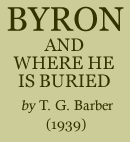< Previous | Contents | Next >
CHAPTER 2.
THE CHURCH AND THE BYRON
FAMILY.
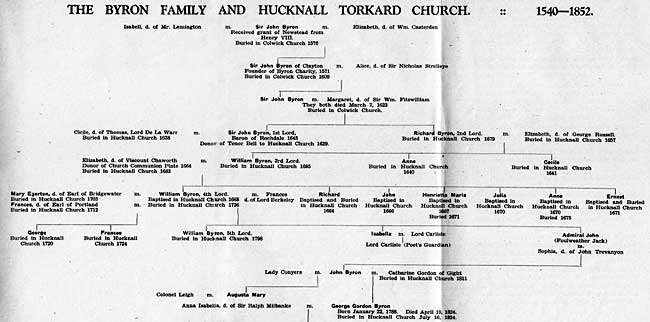 The Byron family and Hucknall Torkard church 1540-1852 (click on the image for a printable PDF version)
The Byron family and Hucknall Torkard church 1540-1852 (click on the image for a printable PDF version)In England the history of the Byron family began with the period of the Norman Conquest, when two nobles of the name of Burun came over with William, and settled in England. Of Erneis de Burun, who held lands in York and Lincoln, we hear little.
Ralph de Burun, the ancestor of the Poet, to whom reference has been made before, is mentioned in Domesday Book (1086) as a landowner in Hochenale (Hucknall Torkard). The entry is as follows: —
“Ralph de Burun’s land (Manor).—In Hochenale “Ulchet had 12 bovates of land to the geld. “Land for 2 ploughs. There Osmund, Ralph’s “man, has one plough, and 5 villeins have 3½ “ploughs. Wood for pannage (pigs’ food), one “league in length, and half a league in breadth. “In King Edward’s time it was worth 30 shill“ings. Now it is worth 15 shillings.”
A number of illustrious names stand out in the history of the family during the next four centuries.
Hugh de Burun, Ralph’s son, inherited his estates, and became Lord of Horestan Castle in the Park of Horseley, and also of other extensive domains in the counties of Derby and Nottingham. He was succeeded by his eldest son, of the same name, who gave a considerable portion of the family estate to Lenton Priory, and devoted himself to the religious life.
John de Horestan, who was a member of the family, distinguished himself as a Crusader under Richard I. He was killed at the seige of Askalon, and was buried in the Church of the Holy Sepulchre.
Robert de Byron lived in the reign of Henry II. It was at this time that the spelling of the family name was changed from Burun to Biron or Byron. By his marriage with the heiress of Sir Richard Clayton, he added to the family possessions an estate in Lancashire.
Sir John Byron served with distinction in the wars with Edward I. and was made Governor of the City of York.
Four generations later, another Sir John Byron was knighted by Richmond, afterwards Henry VII., on his landing at Milford.
Nicholas Byron, his brother, was knighted in 1502 at the marriage of Prince Arthur.
What associations these members of the family had with Hucknall Torkard the chronicler does not relate. Part of the Byron Manor undoubtedly remained in their hands, although it appears that some of the estate was given to Newstead Priory.
Newstead Priory was one of the three religious houses built by Henry II., to atone for the murder of Thomas a Becket, Archbishop of Canterbury. It was founded in 1170, and dedicated to the Blessed Virgin Mary. The Prior and his Brothers belonged to the Order of St. Augustine, and for 370 years the Priory was the centre of the religious life of this district.
The association between Newstead Priory and Hucknall Torkard was very intimate. From 1288 until the dissolution of the Monastery in 1539, the Prior and his Brothers were Patrons of the Living of Hucknall Torkard.
In 1406, John of Hochendale, was Prior of Newstead.
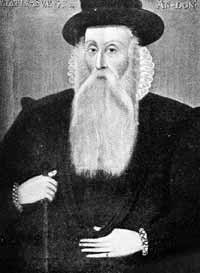 The second Sir John Byron. Founder of the Byron Charity in 1571.
The second Sir John Byron. Founder of the Byron Charity in 1571.In 1540, the year following the dissolution of the Monasteries, the Church and Priory of Newstead, the Church Patronage annexed to it, with certain other lands, was granted for the sum of £800 by Henry VIII. to Sir John Byron. He was at the time Constable of Nottingham Castle, and Master of Sherwood Forest. He was known as “Little Sir John of the great beard,” and appears to have been a great favourite of Henry VIII. Although there is no reference to him in the Parish Registers, it is reasonable to suppose that, as Lord of the Manor, he worshipped upon occasions in the Church of Hucknall Torkard, and took a pious interest in the work of the five Priests who held the cure of the Church between 1540 and 1576, the year of his death.
To him the Church is indebted, so it is conjectured, for the gift of the Treble Bell, which was undoubtedly the Angelus Bell of Newstead Priory. It bears upon it the inscription “Ave Maria.”
His fourth son, of the same name, succeeded him, and his interest in the Church is evidenced by the fact that he was the founder of the Byron Charity on February 1, 1571, by which the Church, and the poor, have during the last 360 years benefited considerably. The original bequest was that of a close of about 21 acres called “Broomhill.” Whilst his father was alive he probably lived at Bulwell Wood Hall. His wife was the daughter of Sir Nicholas Strelleye. In 1579 he was knighted by Elizabeth.
Upon his death in 1609, Newstead Priory passed into the hands of his son, another Sir John Byron, who was knighted at the Coronation of King James I. His wife was Anne, eldest daughter of Sir Richard Molyneux, Bart., by whom he had eleven sons and one daughter. He died in 1625.
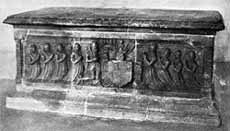 |
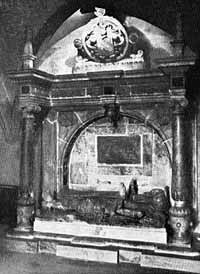 |
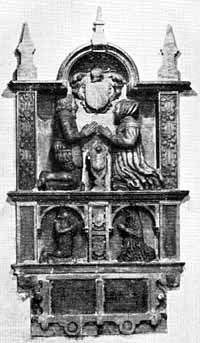 |
| The Altar monument of the first Sir John Byron. 1576. | The canopied monument of the Second Sir John Byron. 1609. | The mural monument of the third Sir John Byron. 1625. |
These three Sir John Byrons were buried in Colwick Church. Their monuments have recently been moved to Newstead Priory.
His successor was another Sir John, his eldest son, who was appointed Governor of the Tower. He took part in the battles of Edgehill and Marston Moor, where he fought side by side with three of his brothers. For his services he was created Baron of Rochdale in 1643. After this he was made Field Marshal of His Majesty’s Forces in Worcestershire, Shropshire, Cheshire, and North Wales. He held Chester against Cromwell, whom he so impressed that he and his forces were allowed to leave the Town under arms. Still further confidence was reposed in him by King Charles I., who appointed him Governor to the Duke of York, afterwards James the Second, with whom he fled to Holland when the King became a prisoner in the Isle of Wight. He died in Paris in 1652.
The Byron Vault in Hucknall Torkard Church was built by him, and his wife, Lady Cicile Byron, was the first to be buried within it. In the Church Register we have the following entry: —

Burialls 1638
Cicile ladie Byron was buried the XXth February.
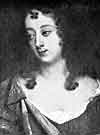
Lady Cicile, the wife of the first Lord Byron.
Although it has been stated that he himself was buried in the vault, there is no evidence of this in the Church Registers.
During the troublous times in which he lived, the Tenor Bell was placed in the Tower of Hucknall Torkard Church. We may assume that this Bell was his gift as the Lord of the Manor. It was cast in George Oldfield’s foundry, Nottingham, in 1639, and for three centuries it has rung out the prayer inscribed upon it, “God save the Church.
Although he was married twice, he left no heir, and his title and estates went to his brother, Sir Richard Byron, who had been knighted by Charles I. after the battle of Edgehill. He is famous for his gallant defence of Newark.
Richard died in 1679. The Registers record his burial as follows: —

Richard Lord Byron was buried the sixth day of October, 1679.
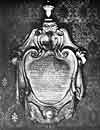
The tablet erected to the memory of Richard Byron,
the second Lord, 1679.
On the North Wall of the Sanctuary of the Church there is a tablet, erected to his memory, which makes reference to his faithful services to Charles I. He, “with his brothers, suffered much for their loyalty and lost all their present fortunes, yet it pleased God so to bless the honest endeavours of the said Richard, Lord Byron, that he repurchased part of their ancient inheritance, which he left to his posterity with a laudable memory for his great piety and charity.”
He was married twice, and both his wives are commemorated on the tablet. His first wife, Elizabeth Russell, died on the 22nd of March, 1657. The tablet states that she was buried in the Vault, but there is no entry of her burial in the Register.
Two of his daughters, Anne and Cicile, were buried in the vault. The entries of their burial appear in the Church Register as follows: —

Buriallss 1640.
Anne Byron, daughter of Richard Biron, Esqre., of Newstead, buried the XIIth of Aprill.

Mistris Sicile Byron, ye daughter of Richard Byron, Esqre, buried the 5th of May (1641).
Other members of the family were buried in the Vault about this time.

Mr. Gilbard Byron was buried the 16th day of March, 1655.
He was at one time Governor of Rhuddlan Castle, and was taken prisoner at Willoughby.

Esquire Byrion (Transcript: William Byron) the sonne of Wm. byrion,
Esq., was buried the 13th of Aprill. (1664).

Mr. Byrion, Londoner, was buried the 15th of
August. Anno Domini 1664.
(Transcript: Thomas Byron, gent of London,
buried the 15th of August).
There are entries of the baptisms of two of Gilbard Byron’s children: —
Ales, daughter of Mr. Gilbard Byron, baptised xiiith April, 1652.
Luce, daughter of Mr. Gilbeard Byron, baptised xxxth October, 1654.
Richard Byron was succeeded by his eldest son, William, who married Elizabeth, the daughter of John, 2nd Viscount Chaworth, of Armagh (died 1644), and his wife Penelope Noel, daughter of Viscount Campden, and so “wove the first link in a strange association of tragedy and romance.” The marriage took place in Papplewick Church, 1½ miles from Hucknall Torkard, on Oct. 18, 1661.

1661. William Byron, esqr., and Elizabeth Chaworth was married ye 18th day of October.
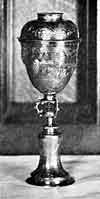 |
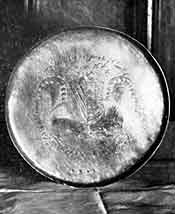 |
|
| The Chalice given to the Church by the Honble. Elizabeth Byron. 1664. | The Paten, given to the Church by the Honble. Elizabeth Byron. 1664. |
Hucknall Torkard Church is indebted to Elizabeth for the gift of a very beautiful silver-gilt Chalice and Paten. The gift was made in 1664, before William, her husband, succeeded to the Peerage.
The Chalice is one of those characteristic English cups called “Steeple Cups,” not, as might be supposed, intended originally for sacred use, but for purely domestic purposes.
The title “steeple” is derived from the high obelisk, or pyramid, crowning the cover, inspired in its form by a conspicuous feature of Elizabethan and Jacobean architecture, and of the grandiose tombs of those periods in English Churches. No steeple cup would seem to have been made, or been known, earlier than the year. 1599— 1600. Two of this date were given some years later, from the family plate of pious donors, to Charing Church in Kent, and to Buckland Church in Devon.
Most of these cups were made by London Goldsmiths between the years of 1604 and 1615. Many such cups have been given as “Loving Cups” to Colleges at Oxford and Cambridge, and to City Companies and Corporations.
A notable instance is the Steeple Cup at St. Ives., in Cornwall, the gift of Sir Francis Bassett, M.P., and appropriately inscribed: —
If any discord ’twixt my friends arise
Within the Borough of beloved St. Ives,
It is desyred that this my cuppe of love
To everie one a peace maker may prove.
The body of the Byron cup of Hucknall Torkard is decorated, appropriately enough for a loving cup, with vines embossed on a matted ground and chased with conventional flat acanthus foliage. In other respects it follows the more common features of these cups, in the short baluster stem supported by three cast scroll brackets with bird-head terminals, a high bell-shaped foot chased with acanthus foliage and with flat straps and scales. Embossed on the cover are vines on a matted ground, as on the body, and engraved on the cover is this inscription :
This cup was given to the Church of Hucknall Torkerd by the honorable Elizabeth Byron, anno 1664.
It is engraved with these arms:
* * * three bendlets . . . . with a label of three points, for Byron, impaling, Quarterly, 1-4, . . . . two chevrons gules; 2-3, . . . . barry of ten argent and vert (gules) three martlets . . . . for Chaworth.
Unfortunately, the cup has lost that conspicuous feature, its “steeple.” The total height at present is 14 inches. The cup bears the London hall-mark for 1608-9 and the cover that for 1609-10.
The second piece, also of domestic origin, is a plain silver-gilt salver with a curved edge on a short trumpetshaped foot. It is engraved with the same arms as the cup within the scrolled feathers characteristic of heraldic decoration of the time of Charles II. and with the following inscription:
This plate and cup was given to ye Church of Hucknall Torkerd by ye honble Elizabeth Byron daughter of ye Right honble Lord Viscount Chaworth anno: 1664.
The first engraver had omitted “Torkerd” from the inscription, and it was added later by another hand.
The diameter is 10½ inches and the height 2 inches.
Stamped upon it is the London hall-mark for 1663-4 with the maker’s mark of RA, and a rose below, in a heart-shaped punch. The maker’s name cannot, unfortunately, be identified because of the loss of the makers’ marks in a fire at Goldsmith Hall in 1681.
Elizabeth, the donor, died in 1683, and her burial is recorded in the Church Registers as follows: —

Elizabeth, wife of the Right Honble. William Lord Byron, was buried June the twentieth, 1683.
Her husband died twelve years later.

The right Honorable Wm. Lord Byron was buried the 16 of November, 1685.
There is a record of his death in the Church Register of the neighbouring Parish of Lynby: —
“Lord Byron died November 13, about halfe an “hour after nine of ye clock at night, and was laid “in ye Vault at Hucknall Torkard ye 16th day “about 8 of ye clock at night.”
